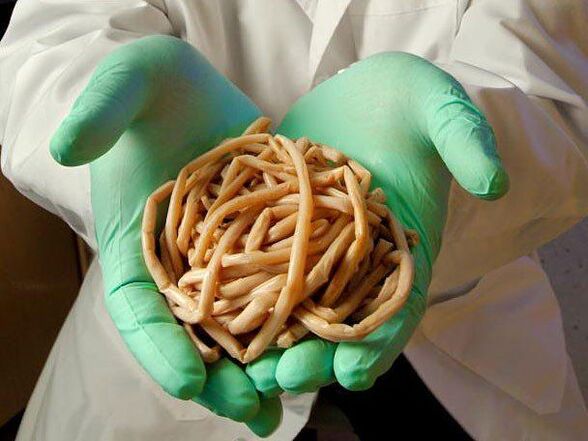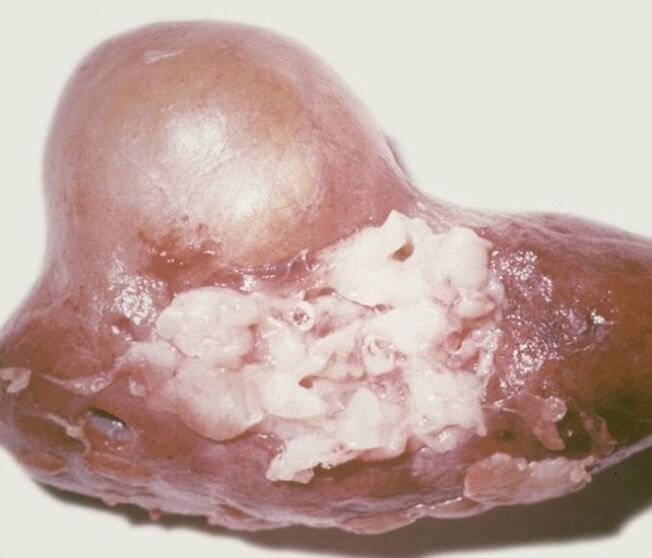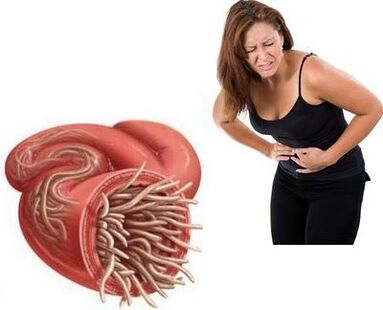Parasites - This is the name of one of the most common groups of infectious diseases.Today, about 300 parasites are known, which are a danger to humans, including a fatal.In the territory of the European continent, these are only a few dozen parasites (medical name - helminthiah, helmintic invasion).
Most relevant parasites for humans are common in countries with tropical and subtropical climate, as well as a low level of socioeconomic development and health culture.
What are the dangerous parasites

Parasites in the human body can affect almost any organ system.The degree of damage depends on the type of helminth, the duration of the disease, the initial state of health.The earlier the diagnosis of specific helm tentn invasion is established, the more likely to get rid of the parasite quickly.This is why it is important to diagnose the condition of invasion with parasites and perform all stages of treatment.
Almost any variant of helminthiasis, especially for a long time, causes significant damage to the human body.The invasion of Hlybon is the reason for the delay in psycho-motor development in children of any age, significantly reduces performance and life reserves in an adult.
Regardless of the age of a person, helm tinty invasion contributes to allergization, reduces the capacity of the immune system to resist infectious diseases and others, and the effectiveness of ongoing vaccine prophylaxis is significantly reduced.
Cleaning the body of parasites in rare cases occurs spontaneously;In most cases, specific treatment is required to do so according to a particular scheme.
What are parasites

Parasites (they are also worms or worms) are an extensive group of multicellular complex organisms that may exist for a long time in an active state in various conditions.An important feature is the ability to exist within another living organism (person or animal), which is called "invasion."
Currently, various types of parasites in the human body are known.The most common classification of parasites, depending on their external structure and the characteristics of the life cycle.
Given the biological characteristics, all parasites are divided into three large classes:
- Round Worms (they are also nematodes), for example, Trichinella, ankylosstoma, pin, Ascaris;
- Tape worms (they are also cestodes), for example, alveococcus, echinococcus, broad ribbon, bull clinical slap, pork and dwarf;
- Supers (they are also tremontods), for example, Opistorch, Fasciol, Clonorch.
In addition, like many other diseases, parasitic diseases differ:
- by gravity;
- By the leading syndrome, that is, which organ system is damaged to the greater extent;
- by the presence and nature of complications;
- By the possible result of the disease.
Parasitic characteristics
Development stage
Parasitic diseases are characterized by various differences associated with the characteristics of parasites and their life cycle.
The number of adults of parasites in the human body does not increase as long as there is no new infection.For the implementation of the life cycle, most parasites require a change in habitat (animal body, soil, etc.).
For any parasite, the stages of development are typical.Throughout the life cycle, Helminto spends a series of stages consistently changing development.As a rule, the parasite egg is transformed into a larva and even more into an adult individual.Reverse development does not occur, the egg cannot immediately go to the stage of an adult.
The parasite penetrates the human body at one stage of its life cycle and goes out to another.It is at this moment that the non -treatment of practical people of human parasitic diseases is associated.That is, it is impossible to be infected with most parasitic diseases in direct contact with an infected person.
Possible paths of penetration in the human body
With many types of parasites, a person can meet anywhere - they are not visible to the naked eye.The following options are more likely:
- The oral path, that is, with non -compliance with personal hygiene, the use of dirty or thermally unqualified products;
- The percutaneous path, that is, larvae or adults of parasites penetrate the human body through damage to the skin, when contacting water or soil, with the participation of insects that disappear blood.
Most parasites that affect the human body live in it only in the adult stage, especially within the digestive tract.These are the so -called intestinal parasites (helminths).They, in turn, are divided into 2 groups according to some resources.
The intestinal parasites of the first group enter the human body in the form of an egg.In the digestive tract, they are transformed into an adult individual.The movements of such parasites (Pinworms, a wide ribbon, pork and tennis) are limited only by different digestive tract departments.
Representatives of the second group (their larvae or eggs) have a significantly longer and more complex migration according to various tissues and organs of the human body.Only after that is an adult individual of the parasite formed.Of course, the symptoms of such parasitic diseases are much more diverse, as the migration process is associated with significant changes in the body.
Parasites, which in the phase of an adult or larvae are located outside the digestive tract are called fabric.If in the human body a parasite exists only in the larvae phase, then a person for him is an eco -out alley that Helmint cannot leave.
Characteristics of the parasites' life cycle
To know how to get rid of the parasites in the body, it is necessary to represent your life cycle in general terms.This knowledge also helps to prevent parasites from entering the human body.
According to the characteristics of the life cycle, all parasites are divided into:
- geographical parasites;
- contagious helminties;
- Bio Helminthiasis.
To implement the life cycle of geographical parasites (Vlasov, a non -core), eggs must be a certain period of time in the soil.In the future, with direct contact with dirty soil, the use of insufficiently washed vegetables, through dirty hands, parasites penetrate the human body.
In contagiosteal parasites (Pinworms, Tabbells Dwarfs), all stages of development occur only in the human body, without a change in the environment.Only these types of parasitic diseases are transmitted directly from person to person.It is also possible, especially in childhood, cases of generation of re -authoring, that is, of yourself in case of non -compliance with hygiene rules and skills.
The most complex life cycle in So -SO biogelmtosis.A prerequisite for the implementation of your life cycle is the presence of an intermediate host.A person can be an intermediary or the final master.For example, with echinococosis, a person is an intermediate host, and dogs and cats are final.In the case of a tusherinchose, by contrast, cattle representatives are intermediate hosts and one person is final.
Parasitic symptoms
The clinical signs of parasites, on the one hand, are determined by the predominant damage to a specific organ, on the other hand, they have general characteristics that allow us to distinguish an acute and chronic stage from a parasitic disease.
The acute phase of a parasitic disease corresponds to the stage of migration of helminth development.It was manifested by clinical signs such as toxic allergic and general reactions (ascariase, schistosomiasis, fascilesia, tricelelosis).
The immune component has a significant weight in the development of the acute phase of parasitosis, forms a certain stereotype of the clinical picture and some similarities with other immunological reactions of a non -infectious nature - drugs, allergic dermatitis and others.
The hidden period with most parasitosis is several weeks, is reduced to 7 to 10 days, with a huge version of the infection and stretches with low intensity.
The main symptoms of parasitic diseases are as follows:
- Increased body temperature - from subebril to high high;
- Pain in the muscles and joints, various durations and intensity;
- The formation of a rash throughout the surface of the skin, different in size and intensity, accompanied by itching skin;
- Significant skin edema and subcutaneous tissue with less frequency - mucous membranes;The most typical for tricelelosis, which gave the disease a characteristic popular name "puffy";
- The development of pulmonary syndrome, namely, night cough, astmitoid states, pneumonia formation with a migrant damage focus;
- the development of abdominal syndrome, characterized by moderate abdominal pain, liquid stools without mucus and blood impurity;
- In severe cases, damage to the nervous system and central heart is observed;
- A distinctive feature of helminthiasis are changes in peripheral blood: pronounced leukocytosis and significant eosinophilia (up to 30-40%).
In treatment at the acute phase of parasitic medicines in the human body, the most effective.
In the phase of the chronic phase of parasitic diseases, the harmful effect is determined by the adult parasite type.The adverse effect on the human body is associated:
- greater toxic and less allergic effects;
- mechanical damage to tissues in the parasitization zone (eg liver echinococcosis);
- Nutrient absorption, a violation of metabolic processes, the development of anemia and cakexy;
- severe anemia;
- greater irritability and excitability of a person;
- It is possible to enter infection and secondary dysbiosis, the weight of the course of other infectious and non -infectious diseases as well as pregnancy.
The duration of the existence of individual parasites is different - from several days and weeks (cutters) to many years.After a parasitic disease, re -infection is possible, since immunity is not formed.Therefore, a cleaning of a time from the parasitic body does not protect against a repeated episode of the disease.
Parasitic treatment

The classic drug therapy of parasitosis in the present has achieved a significant success.The introduction to clinical practice of benzimidazole and imidazole compounds made it possible to successfully treat many types of helm.
These medications have a large spectrum of exposure, small toxide with a brief treatment course for adults and children is convenient to use.The corresponding age of the drug dose should be observed.
How to clean the body of a specific parasite, which treatment regime to choose and which medicine is decided by the doctor.It is not recommended to prevent help from personal initiative as drug addiction develops, ie a decrease in its effects.
Parasitic cleaning
With parasitosis, treatment with folk remedies is no less popular than the means of traditional medicine.Natural tool supporters for parasitic diseases focus on the safety and universality of this therapy.There is a lot of prescription of traditional medicine, which allows you to effectively deal with parasites in the human body.The following options for eliminating parasites in the human body are more famous:
- Coriander and pumpkin seeds as a prophylactic and therapeutic agent for parasites;
- Chantelles alcohol tincture combined with white mushrooms;
- a decoction of pines;
- Green walnut tincture.
Any popular parasitic remedies should be made in accordance with the recipe and clean hands.Before choosing a specific recipe, it is important to ensure that a person has no allergy to the ingredients that are part of the medicine.
How to protect yourself from parasites

It is easy and difficult at the same time.Several simple rules will help minimize the risk of infection with any parasite:
- Washing your hands well;
- The right habit of using an individual set of dishes;
- Process thoroughly process any meat and fish thermally, with caution, use dry and salty fish and meat people;
- Treat vegetables and fruits with boiling water (after washing in running water);
- Always wash your hands with soap after communicating with animals (even domestic).
Parasites infection at any age is an unpleasant problem, but completely eliminating early treatment.






































